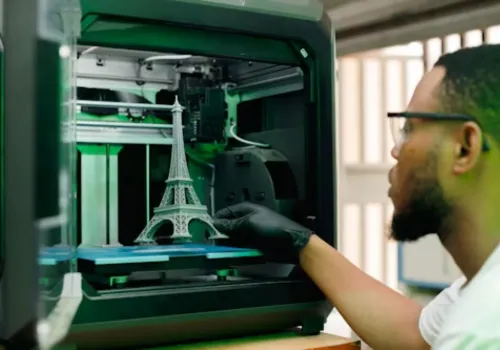
Whether it’s a digital design platform or a hammer on-site, tools have always defined how construction gets done — but technology like 3D printing and AI are now accelerating a major industry shift.

Paola Sanguinetti, director of The Design School at Arizona State University’s Herberger Institute for Design and the Arts, says more automation is key. “The construction industry is fragmented because of the variety of companies and trades. It’s a very complex space, but we’re looking at manufacturing and technology to help bring more efficiency to the process,” she said.
One of the most transformative tools is 3D printing. Entry-level 3D printers are common, but when scaled for construction, they can fabricate walls and structures layer by layer using concrete or other materials. Sanguinetti pointed to research from ETH Zurich exploring ways to use a bed of dry material and heat to bind layers instead — a cleaner and more precise process.
She also noted Habitat for Humanity’s 2021 project that used 3D printing to build more than 70% of a 1,738-square-foot house. “It was amazing what they were able to do,” Sanguinetti said, adding that environmental conditions — like how fast concrete dries — can be a challenge. “Environmental variables are critical to the fusing, drying and curing processes of concrete.”
Sanguinetti’s own research focuses on sustainable mixes like geopolymer concrete, which replaces traditional Portland cement to cut embodied carbon. Materials that absorb and release heat — called phase change materials — can also slim down wall thickness while boosting energy efficiency. “They allow you to reduce the thickness of walls, because those materials absorb and release heat, giving the walls greater insulating properties,” she said.

In commercial projects, some firms now use large 3D printers to prefabricate building components off-site, similar to tilt-up construction, speeding up timelines and cutting labor costs. Still, fine details like facades pose challenges for 3D printing’s precision.
“3D printing is fundamentally shifting the way we build,” Sanguinetti added. “It improves efficiencies, reduces labor need and enables fabrication to happen more quickly, whether it’s happening on site or off it.”
Beyond fabrication, AI is boosting jobsite safety. In April, Sunstate Equipment deployed Netradyne’s Driver•i D-450 system on its fleet vehicles to protect drivers and the public.
“We’ve had at least three situations where the cameras recognized and prompted the driver of a pedestrian that he or she couldn’t see, preventing a potential incident,” said Mike Safsten, Sunstate’s director of safety and risk.
The system issues real-time voice prompts if it detects risky driving. If ignored, it records video clips for managers to coach drivers in real-time — and to reward safe driving too. “I see it as a driving partner as opposed to a way to catch people doing something wrong,” Safsten explained. “Life is hard, and there are more distractions now than ever. These cameras help them see what they cannot and get the load to the customer safely.”
However, he stressed that trust is critical. “Just putting it in place isn’t going to do it. You need a culture that accepts this level of monitoring power in the cab. Without trust, there’s risk of breaking relationships and disrupting operations if you don’t do the groundwork on the human side first.”
These advances signal that construction is entering a new era — one that blends traditional craft with digital precision and data-driven oversight. Large-scale 3D printing can help solve housing shortages, lower carbon footprints and cut build times, but it comes with technical hurdles like weather control, material science and upskilling the workforce.
Meanwhile, AI-powered safety tools are gaining traction in logistics, equipment monitoring and jobsite oversight, helping firms reduce accidents, liability and costs. But as Safsten notes, they only work when workers trust them.
As more construction firms invest in tech and automation, industry leaders say companies that balance innovation with people-focused training and communication will have the edge in a sector that’s rapidly changing from blueprint to build site.
Originally reported by AZ Big Media.